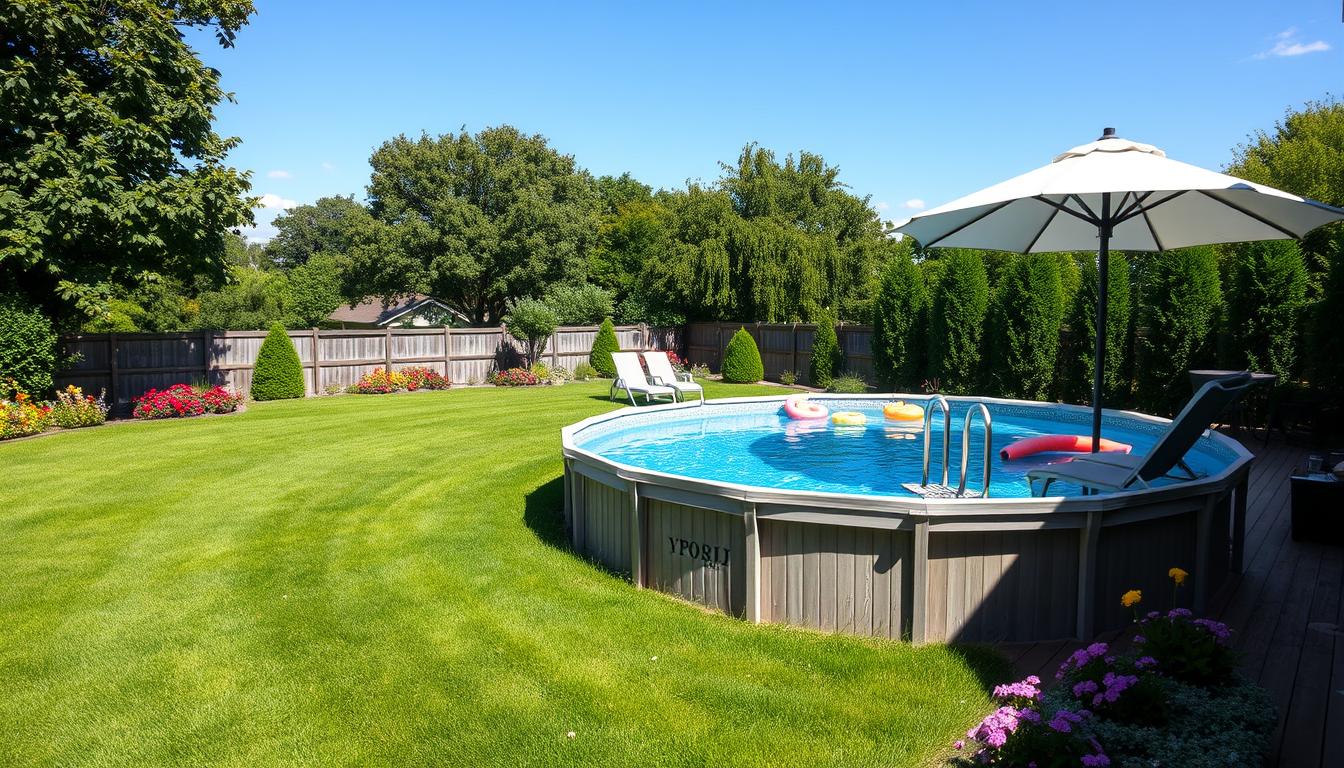
Knowing your above ground pool’s volume is vital for a great swimming experience. It affects safety, cleanliness, and overall enjoyment. The pool’s size determines how much water it needs and the chemicals required.
Pool capacity impacts equipment efficiency, like filters and pumps. It ensures they work well to keep water clean. Understanding gallon capacity helps with maintenance decisions and cost management.
Familiarizing yourself with your pool’s gallon capacity is crucial. It helps you make smart choices about water usage and upkeep. This knowledge leads to better pool management and a more enjoyable backyard oasis.
Key Takeaways
- Understanding pool volume is essential for maintaining a safe and enjoyable swimming environment
- Pool capacity affects chemical treatment, equipment efficiency, and overall maintenance
- Knowing the gallon capacity of your above ground pool helps in making informed decisions about water usage and costs
- Pool size and dimensions directly impact the amount of water needed to fill the pool
- Familiarizing yourself with your pool’s gallon capacity is crucial for proper maintenance and treatment
Understanding Pool Volume: Why It Matters
Knowing your above ground pool’s water volume is vital. It affects water chemistry, maintenance costs, and overall pool care. Understanding water capacity helps keep your pool safe, clean, and enjoyable.
Safety and Hygiene
Pool volume is crucial for proper water chemistry. Correct chemical balance keeps swimmers safe and prevents irritation. Knowing your pool’s gallons helps you add the right amount of treatment products.
This protects everyone’s health and stops harmful bacteria from growing. Accurate calculations ensure a safe and hygienic swimming environment.
Maintenance and Treatment
Regular upkeep keeps water clear and equipment working well. Pool volume affects filtration system efficiency and maintenance frequency. Larger pools may need longer filtration cycles for proper cleaning.
Knowing your pool’s capacity helps optimize your maintenance schedule. This ensures your pool stays in great shape all season long.
Recommendations include having around 20 square feet per person in a pool with a depth of five feet or less, or 15 square feet per person in a pool with a water depth over five feet.
Cost and Environmental Considerations
Pool volume impacts heating, treatment, and water usage costs. Larger pools need more energy to heat, leading to higher bills. The amount of water needed affects your consumption and environmental impact.
Understanding your pool’s capacity helps you make smart choices. You can choose energy-efficient heating and eco-friendly maintenance practices.
| Pool Size (Diameter) | Average Water Capacity (Gallons) | Pump Size (HP) |
|---|---|---|
| 12 ft | 1,600 – 3,400 | 1/2 – 3/4 |
| 15 ft | 3,000 – 5,000 | 3/4 – 1 |
| 18 ft | 5,000 – 7,000 | 1 – 1.5 |
| 24 ft | 10,000 – 15,000 | 1.5 – 2 |
Knowing your pool’s volume is key to safe, clean, and cost-effective swimming. It helps with water chemistry, maintenance, and resource use. This knowledge lets you be a responsible pool owner and enjoy your backyard oasis.
Calculating Gallons in Different Above Ground Pool Sizes
The shape of your above ground pool affects its water volume. Different formulas are used for round and oval pools to estimate gallons needed.
Round Pool Volume Formula
For round above ground pools, use this formula:
Volume = π x radius² x depth x 7.48
π is about 3.14159. The radius is half the pool’s diameter. Depth is the pool’s average depth. 7.48 converts cubic feet to gallons.
Oval Pool Volume Formula
Oval above ground pools use a different formula:
Volume = length x width x average depth x 7.48
Length and width are the pool’s longest and widest points. Average depth is shallow plus deep end depths divided by two. 7.48 converts to gallons.
Common Above Ground Pool Sizes and Gallon Capacities
Here are some typical above ground pool sizes and their gallon capacities:
| Pool Shape | Dimensions | Average Depth | Gallon Capacity |
|---|---|---|---|
| Round | 15′ diameter | 48″ | 5,724 |
| Round | 24′ diameter | 52″ | 16,335 |
| Round | 33′ diameter | 52″ | 28,789 |
| Oval | 15′ x 30′ | 48″ | 15,147 |
| Oval | 18′ x 33′ | 52″ | 20,800 |
| Oval | 21′ x 43′ | 52″ | 30,395 |
This chart shows common pool sizes and their gallon capacities. It helps determine water volume for your pool’s dimensions. Use this info for maintenance, chemical treatments, and water conservation.
How Many Gallons Is an Above Ground Pool: Practical Examples
Let’s explore the water capacity of above ground pools with real-world examples. A 24-foot round pool holds about 14,593 gallons at 54 inches deep. An 18 ft pool with the same depth contains around 8,565 gallons, perfect for smaller yards.
For larger swimming areas, a 30 ft pool is ideal. At 54 inches deep, it holds about 23,793 gallons of water. Oval pools typically contain less water than round ones of similar size.
Water capacity affects pool maintenance costs. Bigger pools need more chemicals and filtration than smaller ones. Quality components like Wilbar’s resin rails and virgin-grade liners can help reduce long-term expenses.
Understanding gallon capacity helps you choose the right pool size. It’s crucial for proper maintenance and safety. Knowing water volume ensures an enjoyable swimming experience for years to come.







